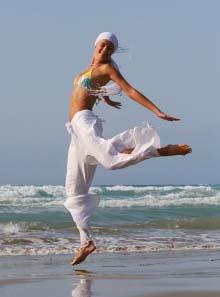 Exercising outdoors in cold weather offers the chance to burn calories in a winter wonderland. Whether the activity is skiing, skating, walking, snow shoeing or jogging, exercising in the chilly air can be invigorating and help keep one’s fitness momentum going all season long.
Exercising outdoors in cold weather offers the chance to burn calories in a winter wonderland. Whether the activity is skiing, skating, walking, snow shoeing or jogging, exercising in the chilly air can be invigorating and help keep one’s fitness momentum going all season long.
Amy Goldwater, M.S., educator, former bodybuilding champion, and physical fitness expert for TOPS Club, Inc. (Take Off Pounds Sensibly), the nonprofit weight-loss support organization, offers the following tips for exercising safely in cold climates. Exercisers should get a doctor’s permission before beginning any fitness program.
* Dress in layers. Ironically, many cold-weather exercisers dress too warmly. Exercise generates a considerable amount of heat. For best results, wear layers that can be removed and put back on as needed. Start with a thin layer of synthetic material such as polypropylene, which “wicks” sweat away from the body. For a middle layer, add fleece for insulation. Top with a waterproof, breathable layer. Goldwater says, “A good rule of thumb for cold-weather exercise is to dress for a day 20 degrees warmer; this allows for the heat generated by exercising. Wind makes a cold day feel colder, so knowing the wind chill factor can help exercisers plan what to wear on breezy days.”
* Protect extremities. Try wearing a thin pair of gloves under a pair of heavier gloves or mittens lined with wool or fleece. Buying exercise shoes a half-size larger than usual will allow for thick thermal socks or an extra pair of regular socks. Note that the body loses most of its heat through the head and neck, so insulate these areas with a hat or ski band.
* Warm up before a workout by walking and stretching; it’s well worth the time. In winter weather, muscles tighten and take longer to loosen than they do in warmer temperatures. Goldwater explains that warm muscles burn fat more readily than cold muscles and that muscle elasticity helps prevent injuries. A warm-up also helps improve the function of the nervous system and the heart. Goldwater’s guideline: “Warm up and cool down indoors in the winter.”
* Choose practical exercise gear. If it’s dark, wear reflective clothing. Choose footwear with enough traction to prevent falls. Wear a helmet for skiing, snowboarding, and snowmobiling. Protect eyes from snow and ice glare with dark glasses or goggles.
* Remember sunscreen. It’s as easy to get sunburned in winter as in summer — even more so if exercising in the snow or at high altitudes. Wear a sunscreen that has an SPF of at least 15. Use a lip balm that contains sunscreen.
* Drink plenty of fluids. Sip water or sports drinks before, during, and after a workout. Exercisers can become just as dehydrated in the cold as in the heat. Goldwater cautions exercisers to avoid drinking alcoholic beverages while exercising in the cold. “Alcohol dehydrates and it’s important to stay well hydrated since people lose water through perspiration and breathing, even in bitter weather,” she notes.
* Know when to go inside. After generating a good sweat, a body becomes more susceptible to the cold, particularly in windy conditions. When finished exercising in cold weather, get back into a warm environment as soon as possible. Being wet and idle in freezing conditions increases the risk of hypothermia. Goldwater says, “Be alert to signs of hypothermia: shivering, drowsiness, disorientation, weakness, loss of coordination and concentration. Watch for frostbite, which is signaled by numbness, pallor, prickling, and itching of the extremities including fingers, toes, nose, and ears. Get inside immediately if signs of frostbite or hypothermia occur.”
* Use common sense to be safe. Goldwater recommends, “On very cold days, stay close to shelter, and don’t go out alone. Having an exercise buddy is always a good idea for safety — and encouragement!”
TOPS Club, Inc. (Take Off Pounds Sensibly), the original, nonprofit weight-loss education and support organization, was founded more than 60 years ago to champion weight-loss support and success. Founded and headquartered in Milwaukee, Wis., TOPS promotes successful weight management with a philosophy that combines healthy eating, regular exercise, wellness education, and support from others at weekly chapter meetings. TOPS has about 170,000 members in nearly 10,000 chapters throughout the United States and Canada, and several chapters in Europe.
Visitors are welcome to attend their first TOPS meeting free of charge. To find a local chapter, view www.tops.org or call 800.932.8677 for more information.
